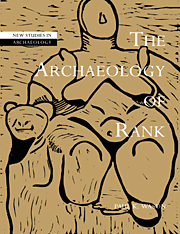Book contents
- Frontmatter
- Contents
- List of figures and tables
- Acknowledgments
- 1 The present study of past society
- 2 Social theory and social life: models of society in the archaeological study of status
- 3 Inequality and social life: a working model
- 4 Mortuary data as evidence of ranking, Part 1
- 5 Mortuary data as evidence of ranking, Part 2
- 6 The form and distribution of artifacts
- 7 Status, settlements, and structures
- 8 Çatal Hüyük: a ranked Neolithic town in Anatolia?
- Notes
- References
- Index
- NEW STUDIES IN ARCHAEOLOGY
7 - Status, settlements, and structures
Published online by Cambridge University Press: 22 August 2009
- Frontmatter
- Contents
- List of figures and tables
- Acknowledgments
- 1 The present study of past society
- 2 Social theory and social life: models of society in the archaeological study of status
- 3 Inequality and social life: a working model
- 4 Mortuary data as evidence of ranking, Part 1
- 5 Mortuary data as evidence of ranking, Part 2
- 6 The form and distribution of artifacts
- 7 Status, settlements, and structures
- 8 Çatal Hüyük: a ranked Neolithic town in Anatolia?
- Notes
- References
- Index
- NEW STUDIES IN ARCHAEOLOGY
Summary
The “built environment” is typically studied at three levels. For the field archaeologist these might be the structure, site, and regional settlement pattern; for the analytical archaeologist the micro, semi-micro, and macro levels (Clarke 1977:9); and for the geographer, the household, community, and region (Hodges 1987:133). The first perspective emphasizes what we as archaeologists have to work with, while the latter reminds us of real people living together. And while Clarke's terminology is not widely favored, scale is clearly central to the use of structures, sites, and their distribution to reconstruct households, community life, and regional interaction. Although these levels tend to blur when applied to the study of inequality, they are useful for ordering the discussion.
The distribution of communities across the landscape
Early studies of settlement archaeology often emphasized the relations “between human groups and the natural environment” (Trigger 1989a:282). This was an important theme, for example, in Robert Braidwood's Iraq Jarmo Project, and Richard MacNeish's Tehuacan Archaeological-Botanical Project. Without ignoring environmental interaction, however, Gordon Willey altered the course of settlement study with his pathbreaking Prehistoric Settlement Patterns in the Viru Valley, Peru (1953), by investigating settlements and their distributions as a reflection of available building technology and “various institutions of social interaction and control” in order to “reconstruct cultural institutions insofar as these may be reflected in settlement configurations” (1953:1). The distribution of communities across a landscape reflects (in addition to environmental and other historical contingencies) primarily “the impact of trade, administration, and regional defence” (Trigger 1989a:285).
- Type
- Chapter
- Information
- The Archaeology of Rank , pp. 127 - 152Publisher: Cambridge University PressPrint publication year: 1994



